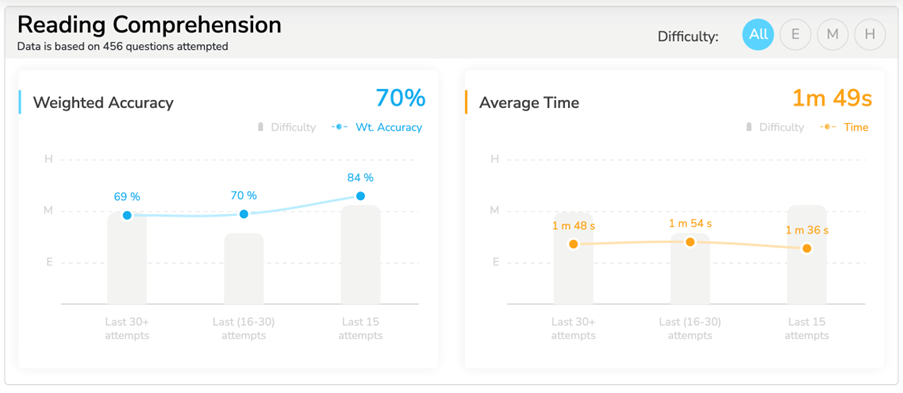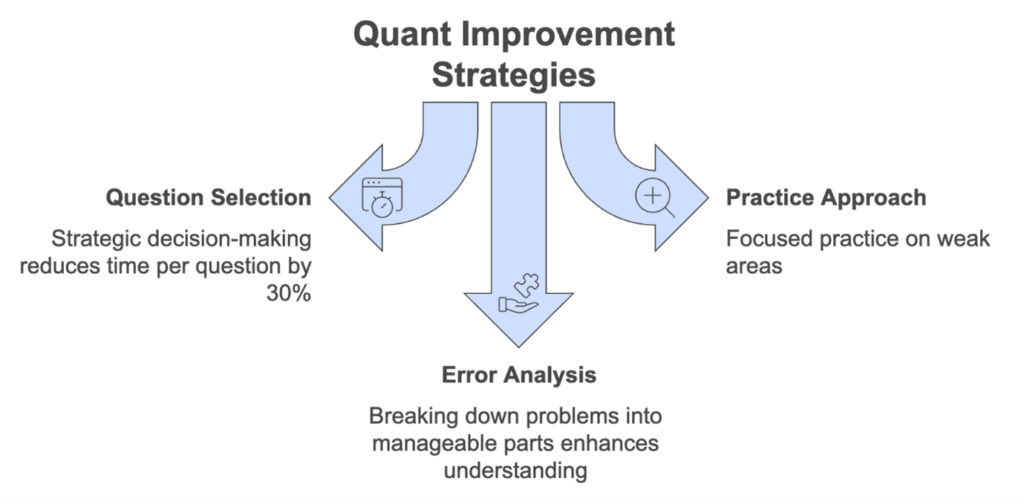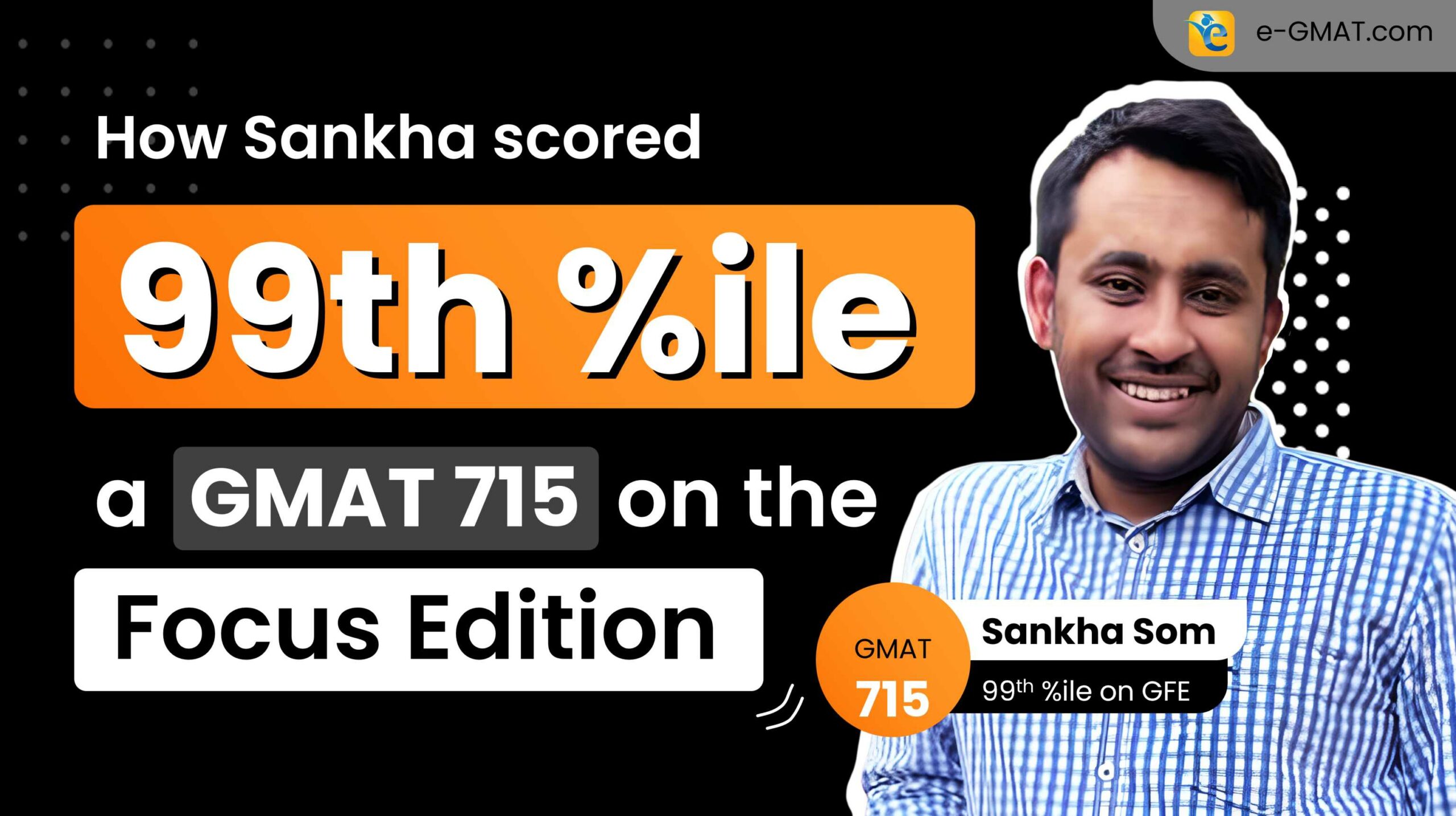For most GMAT aspirants, achieving a 160+ point score improvement takes months of grueling practice. For Radhika, the key wasn’t just about mastering the content; it was about transforming her relationship with test-taking itself. Her journey from scoring in the 500 on the GMAT Classic to achieving a 665 (93rd percentile) showcases how overcoming test anxiety unlocked dramatic improvements across sections and led to a 94th percentile in Verbal to a remarkable 96th percentile in Data Insights.
The Starting Point: Three Critical Barriers
“I remember just calling you out of the blue and I just cried my heart out,” Radhika recalls about one of her early mock attempts. Despite a strong background in English literature, her first mock attempt resulted in a devastating 555, revealing three critical barriers to success.
First, her anxiety manifested in destructive testing behavior. During mocks, she would frequently pause the timer and check answers – a habit that provided temporary comfort but destroyed the value of test simulation. “So many times I would just come to you and tell you that I don’t know why it’s not in my control,” she explains.
Second, her perfectionist approach to questions proved costly, particularly in the Quant sections. Unable to make strategic decisions about when to move on from challenging problems, she would often exhaust precious minutes on single questions. “I would spend all my time focusing on those questions only,” she recalls, “because of which I would lose out on time……”
Third, her approach to content needed renovation. She rushed through verbal passages without true comprehension, prioritized quantity over quality in Quant practice, and struggled with the integrated skills required for Data Insights’s MSR passages, initially scoring below the 70th percentile.
The transformation to GMAT 665 began with a crucial realization: without a structured strategy to manage both preparation and anxiety, even her strong foundation couldn’t translate into the scores she was capable of achieving. This realization led Radhika to completely overhaul her approach to each section, starting with Verbal. Despite her background in English literature, she discovered that GMAT Verbal required a fundamentally different approach than what had served her well in academics.
Verbal: From English Literature to V85
“GMAT is not testing vocabulary… it’s about analysis, it’s about logical reasoning.”
This realization transformed Radhika’s approach to Verbal, leading to her impressive V85 score.
VERBAL TRANSFORMATION
Reading Comprehension: 100th Percentile
- Old Approach: Fast reading, racing through passages
- New Strategy: Paragraph-by-paragraph analysis
- Key Technique: Noting the author’s purpose after each paragraph
- Impact: 100 percentile RC score on test day
Radhika’s Verbal Transformation:
As we can see from the below Scholaranium snapshot -Radhika was able to improve her accuracy from 69% to 84% on RC questions, all the while maintaining an excellent timing of 1’36’’ per question.

Critical Reasoning:
- Core Strategy: Pre-thinking before looking at answer choices
- Implementation: Predicting logical answers before reviewing options
- Result: Consistent accuracy improvement in practice tests
“For critical reasoning, pre-thinking really helped me a lot,” Radhika explains. “You can’t go into GMAT with the idea of first reading the passage and then getting on to eliminating answer options. You need to have a fair idea of what your answers should look like.”
As with RC, Radhika’s CR Assumption Scholaranium statistics display her excellent internalization of the pre-thinking approach. She Improved to a fantastic 81% accuracy while bringing her time down from 2’6’’ to 1’18’’, proving that once you have the right ability in hand, you can absolutely improve your timing.

With these strategic changes in both Reading Comprehension and Critical Reasoning, Radhika’s Verbal score transformed from a point of anxiety to a strength. Her success in achieving V85 proved that even with a strong English background, it was the right approach – not just language skills – that made the difference in GMAT Verbal. This same methodical mindset would serve her well as she tackled her next challenge: the Quant section.
Quant: Quality Over Quantity
Radhika’s Quant transformation came through three key strategic shifts:

First, she revolutionized her question selection strategy. Instead of getting bogged down by difficult questions, she learned to make strategic decisions about when to move on. “I remember you telling me in one of the one-on-one sessions that it’s okay if there is one question that you’re not able to get right, please decide to let go of it and move on to the next question,” she recalls. This shift alone reduced her average time per question by 30%, giving her the breathing room needed for better performance.
The second shift came in her practice approach. Initially, she believed success in Quant meant solving as many questions as possible. “I would think that if I’m practicing Quant, the idea is just to keep solving questions, as many questions as I can,” she explains. Her mentor helped her realize that quality trumped quantity. She shifted to focused practice on identified weak areas, making each practice session more purposeful and effective.
Finally, she developed a systematic approach to error analysis. By maintaining a detailed error log, she identified number properties and word problems as her key challenge areas. For word problems in particular, she developed a specific strategy of breaking down complex questions into smaller, manageable parts. “You need to learn how to break the question down into as many parts as you can and read it as one statement at a time,” she explains. This methodical approach transformed previously intimidating questions into structured challenges she could tackle confidently.
“You need to learn how to break the question down into as many parts as you can and read it as one statement at a time.”
Key skills that helped Radhika improve her Quant score:
Through this three-pronged approach – strategic question selection, focused practice, and systematic error analysis – Radhika turned her Quant performance around. As we can see in the case of Word Problems – her three-pronged approach allowed her to improve her accuracy on hard questions to a consistent 70%+ indicating a 95th percentile ability.

Her newfound ability to make strategic decisions under time pressure wouldn’t just help in Quant; it would prove crucial for her outstanding performance in Data Insights, where integrating multiple skills under tight time constraints was essential.
Data Insights: Achieving 96th Percentile
The DI section, particularly MSR (Multi-Source Reasoning), initially proved challenging but ultimately became one of Radhika’s strongest performances.
DI MASTERY APPROACH
MSR Strategy:
- Treated passages as a fusion of verbal and quant skills
- Systematic breakdown of graphical and tabular data
- Integration of reading comprehension techniques
- Result: 96th percentile in DI
Two-Part Analysis:
- Initial Challenge: Time management
- Solution: Systematic approach to answer elimination
- Practice Focus: Accuracy before speed
“For DI, my strategy was fairly simple,” Radhika explains. “Even if I’m solving 10 questions a day, I will spend twice the amount of time analyzing those questions and seeing where I got those questions wrong.” This methodical approach, combined with regular reviews of the e-GMAT modules, led to her exceptional DI performance.
Radhika’s challenges in DI:
This methodical mastery of Data Insights, particularly the challenging MSR component, completed Radhika’s technical transformation. Her approach to DI embodied everything she had learned throughout her GMAT journey: the importance of structured analysis from Verbal, the strategic time management from Quant, and most importantly, the confidence to tackle complex, integrated problems. This comprehensive strategy paid off brilliantly – she achieved a remarkable 96th percentile in DI, making it her strongest section on test day.
Yet Radhika understood that even the best strategies needed proper guidance to reach their full potential. Having transformed her approach to each section, she turned to structured mentorship through the Last Mile Program to bring all these elements together. This decision would prove crucial in converting her improved sectional performances into consistent overall success.
The Power of Structured Support: More Than Just Guidance
The Last Mile program proved transformative in Radhika’s journey, providing the structure and support needed to turn her potential into performance. “Last mile program helped me tremendously,” she emphasizes. “It’s very important to have that one guiding factor in your life, who is able to strategize that approach for you.”

“I remember in the initial days of this program when you reached out to me, the first thing that we discussed was that there is no strategy that I was following at that point of time,” Radhika recalls. “I was just all haywire, one day I was solving a question from one topic, the other I had completely switched to a different section altogether.”
As we can see below – Radhika’s mentor Abha created a detailed plan that allowed Radhika to focus on the right areas and push her abilities –

Personalized Problem-Solving
The mentorship went beyond just creating study plans. Having a mentor meant having someone who could identify patterns in her mistakes and develop targeted solutions.
“There’s someone who’s able to guide you through, who’s able to identify the kind of consistent mistakes that you’ve been making, who’s able to lay things down for you in a very, very concrete manner.”
For instance, when Radhika struggled with time management, her mentor helped break down the problem into manageable steps. “We would get on to a call, ideate, figure out a solution,” she explains. “And that is how things turned out to work in my favor.”
The regular check-ins proved crucial for maintaining momentum. Rather than waiting for major issues to develop, Radhika could address challenges as they arose. “I did not feel alone at any point of time during the preparation,” she notes. “I knew that if there is a challenge, I can sort of voice it out to you, reach out to you at any point of time.”
Beyond Technical Support

The mentorship proved particularly valuable in managing test anxiety. “I remember even you would relate to this, we’ve had more discussions on test-taking skills than on building on to certain sections,” Radhika reflects. These conversations helped her develop a healthier relationship with the test itself.
In the crucial final weeks, her mentor helped her maintain perspective. “I remember you telling me that Radhika, GMAT is not your life, it is a part of your life.” This shift in mindset, combined with structured preparation, helped her approach the test with confidence rather than anxiety.
The mentorship experience highlighted a crucial truth about GMAT preparation: having the right guidance can transform not just your score, but your entire approach to the test. For Radhika, it was the difference between knowing what to study and knowing how to succeed.
How did mentorship support help Radhika in her prep?
From Strategy to Success: The Final Phase
The true test of Radhika’s transformation came in the weeks leading up to test day. With consistent mock scores now in the 655+ range, the focus shifted to sustaining her performance under real exam conditions.
“In my final days, I was just relaxing,” Radhika reveals, highlighting a crucial insight.
“Don’t spend hours cramming formulae or practicing thousands of questions. You have done everything you can now. There is nothing that can be done now.”
This measured approach marked a complete transformation from her earlier anxiety-driven preparation.
The final exam showcased her transformed approach. Starting with Quant helped her settle her nerves. By the time she reached Verbal, she was in her comfort zone. “When I got to DI, I had that confidence in me,” she recalls. This strategic sequencing, combined with her new mindset, allowed her to maintain focus throughout the test.
Key Success Factors
WINNING FORMULA
- Quality Over Quantity “Focus on the quality and not the quantity of questions”
- Strategic Time Management “It’s okay to let go of a question if you don’t know the answer”
- Mindset Management “GMAT is not your life; it is a part of your life”
Rather than trying to solve every difficult question, she maintained her strategy of making smart decisions about question selection. When challenging questions appeared, she avoided her old pattern of getting stuck. Instead, she trusted her preparation and moved forward strategically.
“By the time I got to the exam,” Radhika reflects, “I had already given plenty of mocks. So I was comparatively very relaxed.” This calm confidence, built through structured preparation and strategic practice, made all the difference.
Her final advice encapsulates the essence of her transformation: “GMAT is more about consistency. GMAT is more about strategy than it is about the number of hours you put in your preparation.”
Radhika’s journey from scoring in the 500s to achieving a 665 demonstrates that GMAT success isn’t just about knowledge accumulation – it’s about developing the right approach, maintaining consistency, and building confidence through structured preparation. Her story shows that with the right strategy and support, even severe test anxiety can be transformed into a catalyst for success.
Are you planning to pursue MBA at top business schools? Let us help you conquer the first step of the process i.e., taking the GMAT. Take a free mock test to understand your baseline score and start your GMAT prep with our free trial. We are the most reviewed online GMAT Prep company with 2000+ five star reviews on GMATClub.















